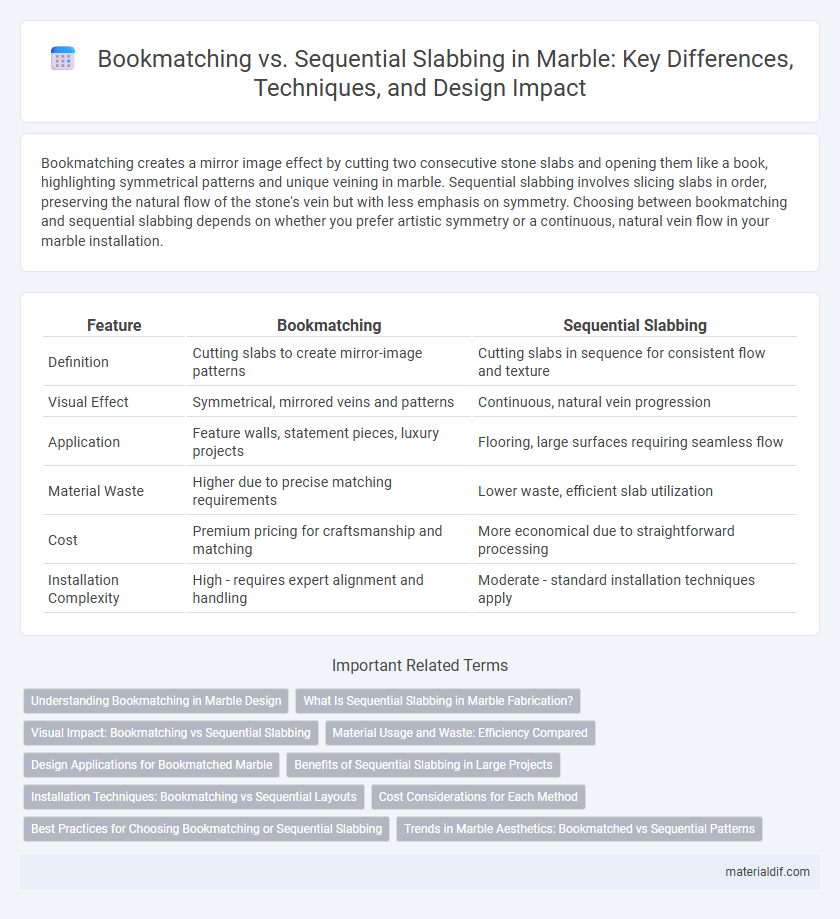Bookmatching creates a mirror image effect by cutting two consecutive stone slabs and opening them like a book, highlighting symmetrical patterns and unique veining in marble. Sequential slabbing involves slicing slabs in order, preserving the natural flow of the stone's vein but with less emphasis on symmetry. Choosing between bookmatching and sequential slabbing depends on whether you prefer artistic symmetry or a continuous, natural vein flow in your marble installation.
Table of Comparison
| Feature | Bookmatching | Sequential Slabbing |
|---|---|---|
| Definition | Cutting slabs to create mirror-image patterns | Cutting slabs in sequence for consistent flow and texture |
| Visual Effect | Symmetrical, mirrored veins and patterns | Continuous, natural vein progression |
| Application | Feature walls, statement pieces, luxury projects | Flooring, large surfaces requiring seamless flow |
| Material Waste | Higher due to precise matching requirements | Lower waste, efficient slab utilization |
| Cost | Premium pricing for craftsmanship and matching | More economical due to straightforward processing |
| Installation Complexity | High - requires expert alignment and handling | Moderate - standard installation techniques apply |
Understanding Bookmatching in Marble Design
Bookmatching in marble design involves slicing a single marble slab into two consecutive slabs that mirror each other when placed side by side, creating a symmetrical pattern reminiscent of an open book. This technique enhances visual appeal by highlighting natural veining and patterns, providing a dramatic and harmonious aesthetic ideal for feature walls or tabletops. Unlike sequential slabbing, which focuses on using slabs in their natural order for consistency, bookmatching emphasizes artistic symmetry and visual impact.
What Is Sequential Slabbing in Marble Fabrication?
Sequential slabbing in marble fabrication involves cutting large marble blocks into slabs in a continuous, ordered sequence, preserving the natural vein patterns across each slab. This method ensures consistent color flow and pattern alignment, ideal for projects requiring uniformity and natural aesthetics. Unlike bookmatching, which pairs slabs with mirrored patterns, sequential slabbing maintains a linear, natural progression of the marble's texture and veining.
Visual Impact: Bookmatching vs Sequential Slabbing
Bookmatching marble creates a striking symmetrical pattern by mirroring two adjacent slabs, enhancing the visual impact with a dramatic and artistic effect ideal for feature walls and statement pieces. Sequential slabbing follows the natural flow of the stone's veining in a linear progression, producing a continuous and harmonious look that emphasizes the marble's natural texture. Both techniques showcase the marble's unique beauty, with bookmatching offering bold symmetry and sequential slabbing emphasizing organic continuity.
Material Usage and Waste: Efficiency Compared
Bookmatching marble slabs involves slicing stone blocks into consecutive slabs that are mirrored to create symmetrical patterns, maximizing the use of material by reducing offcuts. Sequential slabbing cuts through the block in order, but does not pair slabs for matching patterns, often resulting in higher waste due to irregular cuts and less uniformity. Therefore, bookmatching is more efficient in material usage and minimizes marble waste compared to sequential slabbing.
Design Applications for Bookmatched Marble
Bookmatching in marble design creates symmetrical, mirror-like patterns by pairing consecutive slabs, enhancing visual impact ideal for feature walls, countertops, and flooring in luxury spaces. Sequential slabbing offers uniformity by slicing slabs in order, providing consistent veining but lacks the dramatic symmetry of bookmatched marble. Designers prefer bookmatching for bespoke, artistic applications where unique, eye-catching aesthetics elevate architectural and interior elements.
Benefits of Sequential Slabbing in Large Projects
Sequential slabbing offers significant benefits in large marble projects by ensuring consistency in color and veining across extensive surfaces, which is crucial for achieving a harmonious aesthetic. This method reduces waste by allowing precise cutting aligned with the natural layers of the stone, optimizing material use and lowering costs. Furthermore, sequential slabs facilitate streamlined project management and installation, as they simplify matching and reduce the need for additional sorting or adjustments onsite.
Installation Techniques: Bookmatching vs Sequential Layouts
Bookmatching in marble installation involves aligning two slabs so their veining mirrors each other, creating a symmetrical and visually striking pattern ideal for feature walls or countertops. Sequential slabbing arranges slabs in their natural quarry order, preserving the stone's color and texture flow for a more organic and continuous appearance. Both techniques require precise cutting and careful handling to ensure seamless joints and maintain the marble's structural integrity during installation.
Cost Considerations for Each Method
Bookmatching marble involves pairing two slabs to create a mirror image, often resulting in higher waste and increased labor costs due to precise alignment requirements. Sequential slabbing produces uniform slabs with minimal waste, making it more cost-effective for large projects requiring consistent patterns. Choosing between methods depends on budget constraints and the desired aesthetic complexity, with bookmatching typically demanding a premium.
Best Practices for Choosing Bookmatching or Sequential Slabbing
Bookmatching in marble creates a symmetrical, mirror-image pattern that enhances visual appeal, making it ideal for feature walls or focal points where aesthetics are paramount. Sequential slabbing preserves the natural flow and continuity of marble veins, best suited for large floor areas or countertops where consistency and uniformity are desired. Selecting between bookmatching and sequential slabbing depends on project design goals, slab availability, and the importance of pattern symmetry versus natural vein continuity.
Trends in Marble Aesthetics: Bookmatched vs Sequential Patterns
Bookmatching in marble highlights mirror-image patterns that create dramatic, symmetrical aesthetics highly sought in luxury interiors and statement walls. Sequential slabbing emphasizes natural continuity by showcasing the stone's flow, appealing to modern minimalistic and organic design trends. Both techniques influence marble's visual impact, with bookmatching trending in high-end projects and sequential patterns favored for subtle elegance.
Bookmatching vs Sequential Slabbing Infographic

 materialdif.com
materialdif.com